For Individual Investors
Reports of “Captivating Experiences”

“Captivating Experiences” is the value SEGA SAMMY Group has been pursuing that exceed customers’ expectations. We introduce the scenes you can only find here such as behind-the-scenes of the development process, feature articles and others.
- Reports of “Captivating Experiences”
-
2025.06.19
The Growth Strategy of TMS in an Expanding Anime Market
Since its establishment in 1964, TMS ENTERTAINMENT (hereinafter “TMS”), a subsidiary of the SEGA SAMMY group, has produced countless works of anime that have been loved by a large spectrum of fans in all ages, spanning across generations. TMS is one of Japan’s foremost anime production studios.
With the emergence of online distribution platforms, the anime market is facing a time of vast transformation. Amid a rapidly expanding demand for Japanese anime from Europe, the Americas, and Asia including China, TMS is taking on many challenges by accelerating its global development and reforming its profit structure.
In this Captivating Experiences report, we will introduce the growth strategy that TMS pursues in the anime industry, which is currently undergoing a period of change, and its prospects for the future.
1. Growth of the DETECTIVE CONAN Movie Franchise
Starting with Big X in 1964, a piece from the dawn of Japanese anime, TMS has created numerous works in various genres such as LUPIN THE 3rd, ANPANMAN and BAKI, making a pivotal contribution to the development of anime culture.
Among these, TMS has been continuously producing for the ever popular theatrical franchises of Detective Conan and ANPANMAN. The 2024 releases, Detective Conan: The Million-Dollar Pentagram and ANPANMAN: Baikinman and Lulun in the Picture Book, both broke box-office records for their respective series.
In particular, the Detective Conan franchise has recently achieved spectacular growth. Except for the movies released during the 2020-2021 COVID-19 pandemic, the series has surpassed its box-office revenue year after year for eleven years in a row. The latest release, Detective Conan: The Million-Dollar Pentagram (2024), surpassed 15.8 billion yen in box office revenue, making it the top biggest earning movie in Japan in all of 2024.

One of the factors behind this growth is strengthening the ties between the movies and the original manga.
By adding features to the movie that make the original manga even more enjoyable, fans of the original work returned to movie theaters. In addition, popular characters such as Toru Amuro and Shuichi Akai have captured younger fans new to Detective Conan leading to fans who go to theaters on repeat.
Moreover, by using famous guest voice actors and collaborating with theme parks, exposure on TV and in magazines has greatly expanded, led to an increase in the awareness of the movies to a wide range of generations from children to adults.
In this way, TMS performs well, centering on anime movie franchises such as ANPANMAN and Detective Conan. On the other hand, TMS also takes on the challenge of new initiatives in order to respond to the changing anime market.
2. The Changing Anime Market
Expansion of the Overseas Market due to the Growth of Online Distribution Platforms
With the rapid spread of subscription video on demand (SVOD) services such as Netflix and Crunchyroll, dynamic changes are occurring in the anime market.
These SVOD services have made it possible to watch anime works beyond national boundaries and have become a new infrastructure for delivering Japanese anime to viewers around the world.
As a result, overseas sales of Japan’s anime industry have rapidly expanded, from 282.3 billion yen in 2013 to 1.722 trillion yen in 2023, which is the scale of 6.1 times over 10 years.
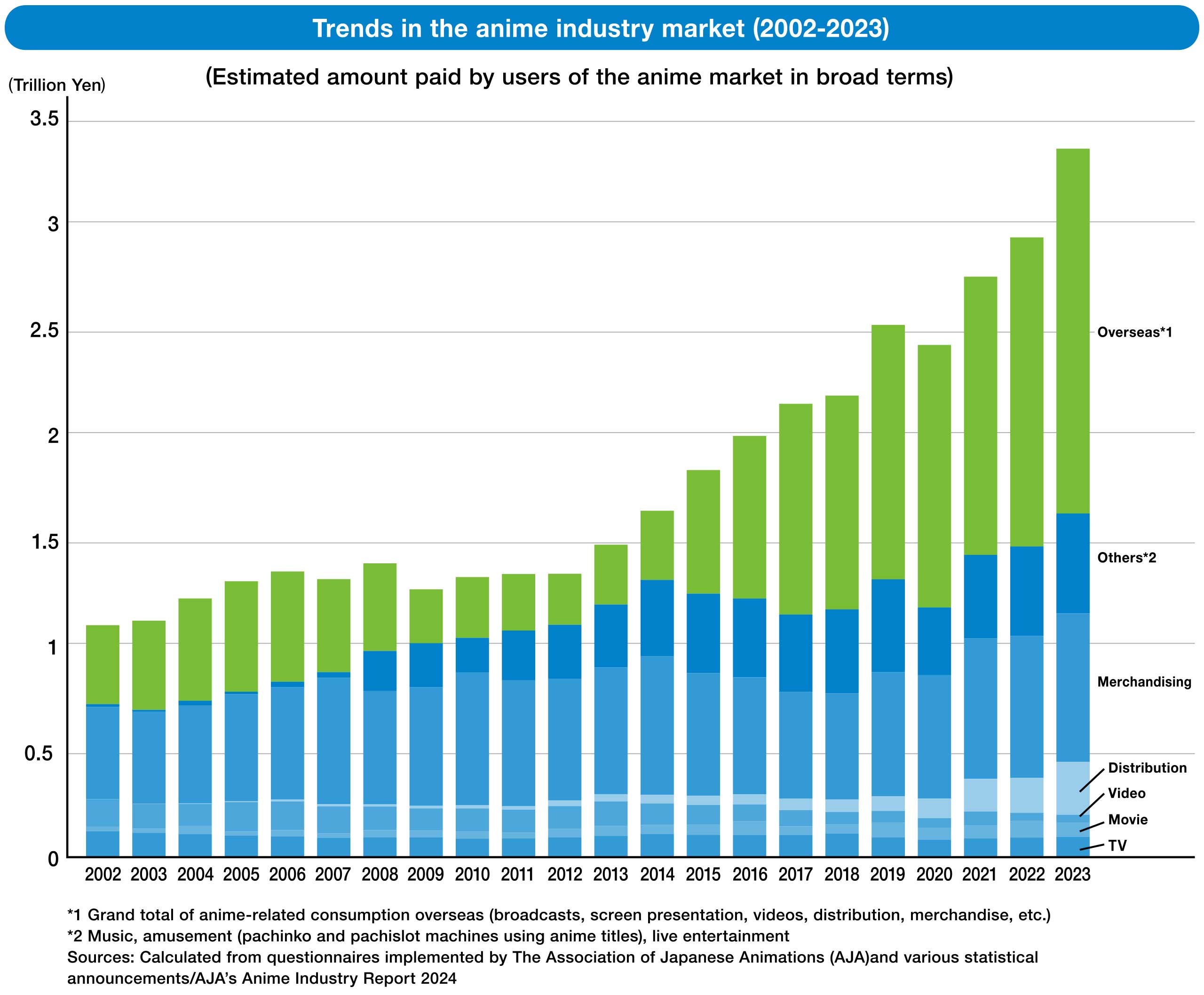
In order to respond to the changes in the market environment described above, TMS is working on expanding its licensing business that provides content for online distribution platforms which is an emerging business.
The Challenges of New Genres and Global Distribution Success
TMS has been particularly adept at providing family-friendly anime, but in recent years it has looked ahead to developing its online distribution business and is tackling new challenges such as the adaptations of popular comics to anime. Some examples of this are Dr. STONE and SAKAMOTO DAYS which target a wide age-range of audiences.
The highly acclaimed SAKAMOTO DAYS has been distributed worldwide on various platforms, recording the second-highest weekly* viewing figures on the Global Top 10 “Non-English Shows” category within Netflix.
*During the period of February 24th to March 2nd of 2025
Why has TMS been able to produce these works that are successful in the global market? Behind this success lies a reform of its profit structure.
3. The Challenge of TMS to Reform its Profit Structure
Issues in the Method of Production Committees Producing Animes
The environment surrounding the anime industry is rapidly changing, and there is a need to produce high-quality titles that can be appreciated worldwide. Against this backdrop, the Japanese anime industry faces the major problem that sufficient profits are not returned to most anime production studios, and this issue is closely linked to the funding procurement methods in anime production.
The currently prevalent system of anime production, the “production committee format,” a business model in which various companies jointly fund the production costs and receive profits commensurate with the percentage of their investment. It is therefore a structure in which those companies who are the member of production committee can obtain large profits when a title becomes a commercial hit.
However, the anime production studio that are contracted by the production committee to produce anime can only obtain the outsourcing fee regardless of whether the title becomes a hit or not. (See Fig. 1)
Reform of TMS’s Profit Structure
To break free from this structure, TMS aimed to shift its position from the role of sub-contractor as an anime production studio to a main player in producing and distributing projects. Specifically, TMS strengthened its sales & marketing divisions, built up a track record of sales work towards overseas online distribution, and expanded the scope of its investment ratios as well as the sales work it took charge of – while gaining the trust of stakeholders – creating a structure where TMS itself plans the production of titles, thereby fulfilling the central role in production committees.
As a result, TMS has been able to gain profits other than the outsourcing production fees. From the allocated revenue based on their investment ratios and handling fees, as well as the revenue from merchandising and licensing out to makers, program sales such as overseas distribution licenses, and the sales of character goods, DVDs, and game software.
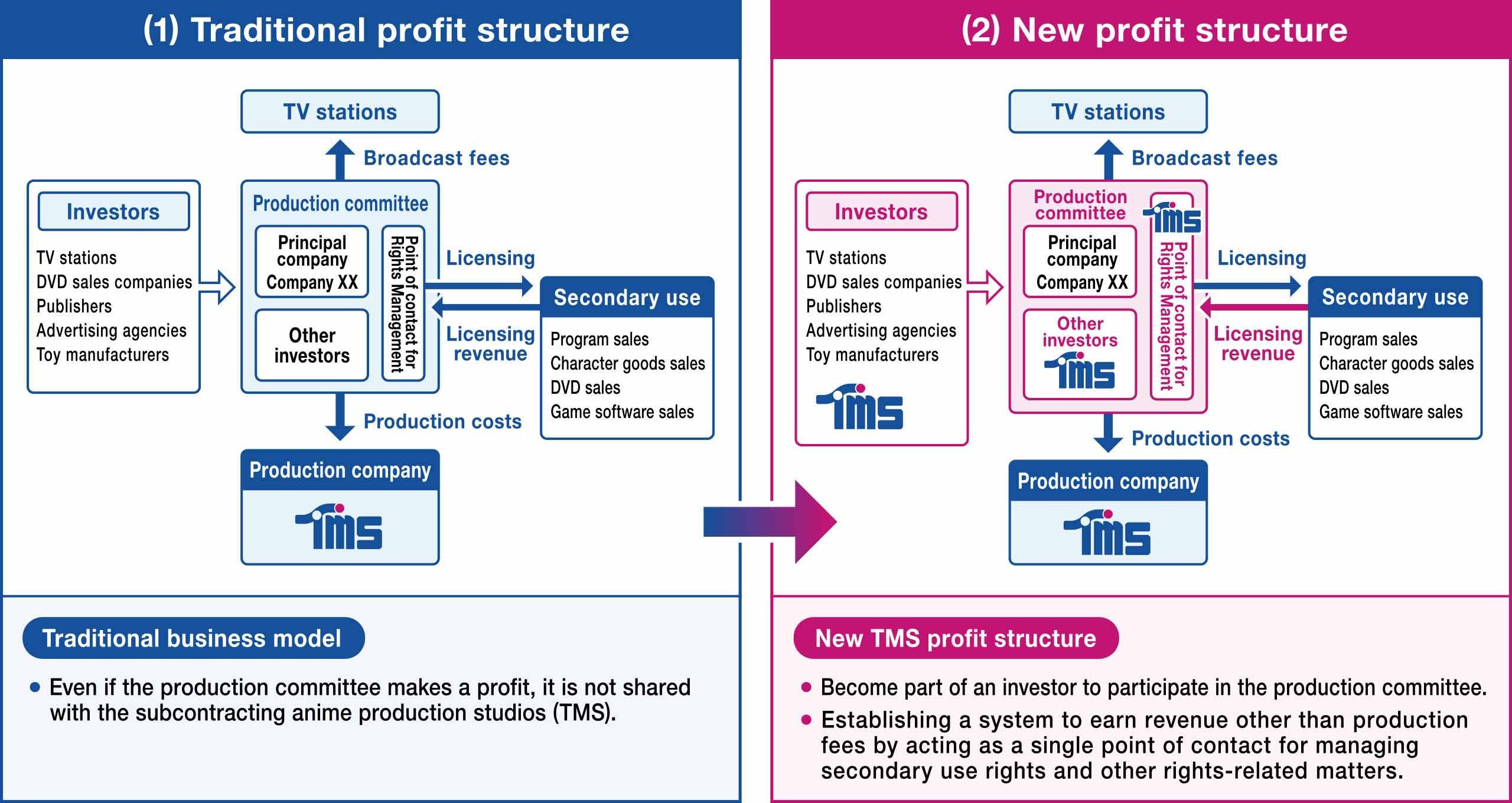
The Challenge of Industry Reform Through the “UNLIMITED PRODUCE” Project
TMS had developed the foundations of being able to conduct the whole range of business related to anime, launching a new challenge: the “UNLIMITED PRODUCE” project, which aimed to create titles that were planned and produced by TMS but in cooperation with external studios.
About the “UNLIMITED PRODUCE” project
TMS aims to meet the globally expanding needs for Japanese anime and develop a system that enables the worldwide supply of an even wider range of titles, in terms of both genre and expression. To this end, in parallel with the operation of its in-house production line, TMS is pursuing initiatives to enhance its “self-produced titles,” in which TMS itself plans, produces, manages and publicizes new titles in cooperation with external studios.
Under the “UNLIMITED PRODUCE” project, TMS launches a production committee as the principal company, securing the leadership initiative through investment ratio of 70% to 80%. This enables TMS to control a majority of the business. In addition, TMS has created a structure so that when a title becomes a hit and the production committee earns profits, profits are also returned to the external anime production studios in charge of the production itself. The word “UNLIMITED” in the project name is used to signify the wish to “change the structure of the anime business and production committee format in an unlimited manner.”
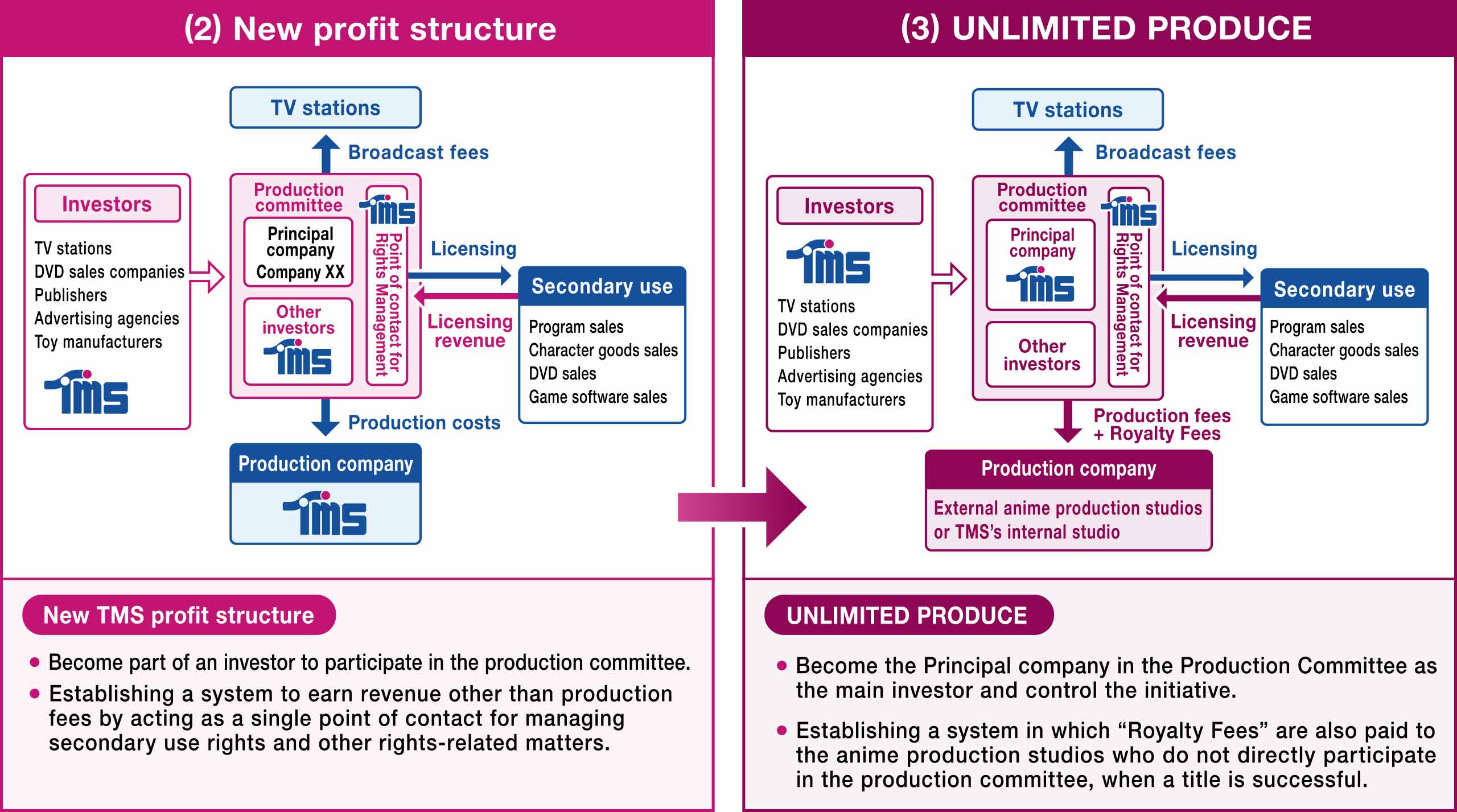
Titles created under the “UNLIMITED PRODUCE” project include Honey Lemon Soda, Blue Box, and much more.
By returning part of the profits to the anime production studios through this initiative, a benign cycle allowing high-quality anime to be produced is generated.
4. Fostering the Next Generation through the TMS Drawing Academy
Issues within Anime Production Studios
While the anime market expands, huge changes are also occurring in the environment surrounding the anime production studios.
In recent years, the number of anime production studios have increased, and there are currently around 700 of them in Japan. On the other hand, the resulting severe shortage of human resources is exerting a large impact upon the production work space, becoming a serious issue requiring initiatives by the entire anime industry.
The Initiative of TMS with an Eye on the Future
In order to address this issue, TMS takes countermeasures from the aspects of both technology and the fostering of human resources. On the technical side, it is conducting research and development of the use of AI in anime production. It is pursuing the development of an environment in which creators can exert more of their efforts on creative work by using AI for menial tasks and as production assistance.
On the human resource fostering side, TMS has relied on freelance animators for over 30 years, but in order to address the shortage of human resources, TMS opened the TMS Drawing Academy (hereinafter “the Academy”) in FY2021/3 and started the initiative to foster young in-house animators.
Not only are the tuition fees at the Academy free of charge, but funds in the form of scholarships are also offered to students to assist them in their daily lives. In addition, professionally working animators teach them the fundamentals of drawing including practical work, over the space of the year as instructors. After completing the curriculum, graduates can receive further training as contract staff of TMS based on their aptitude and preferences.
What sort of instruction is actually provided at the Academy? We spoke to instructors T and M, who work in the teaching place, and Academy graduate T, about the fostering of human resources to carry out animation work in the future and the learning experience at the Academy.
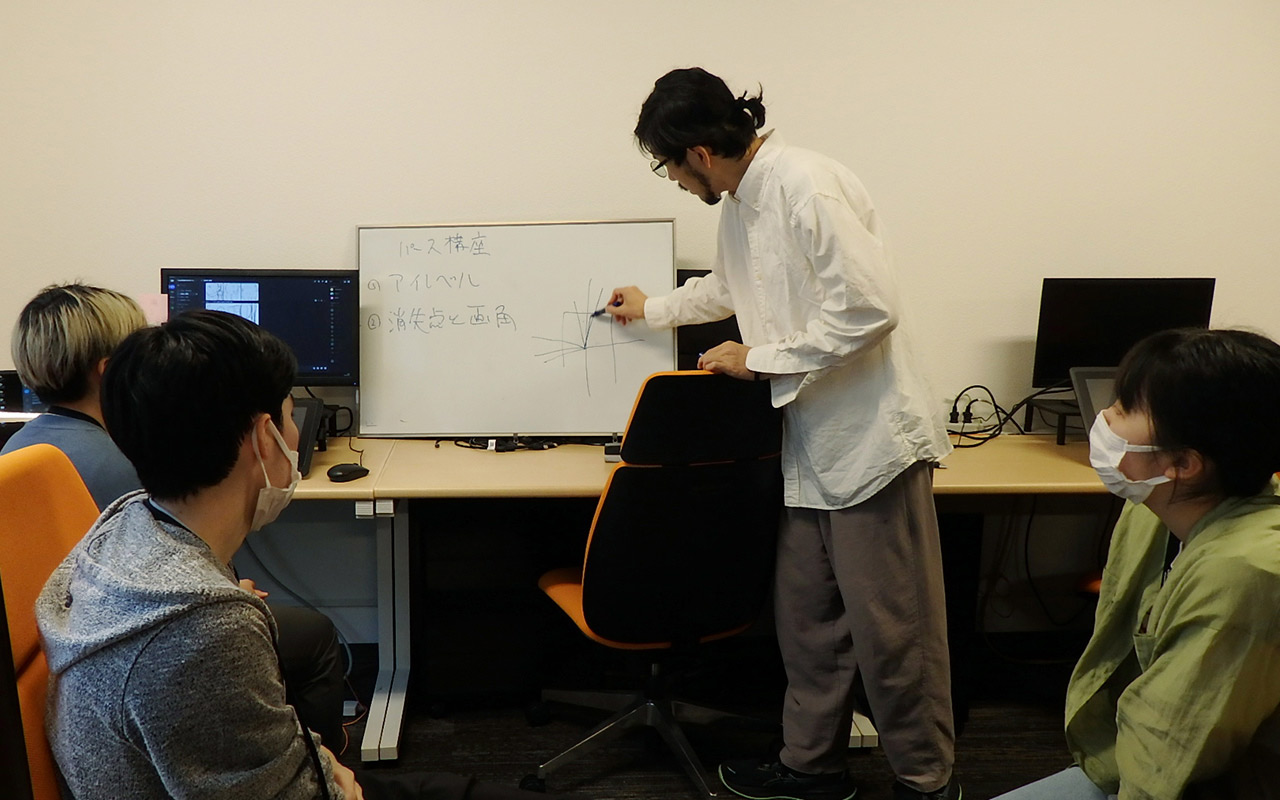
Interview with Instructor T: Animator Fostering Guidance
・What aspects do you put a particular effort in your instruction at the Academy?
I’m conveying the importance of occupation who serves “key animation drawing,” which is the foundation stone of animation quality. In line with the individual ability of each student, I carefully teach the skills required for producing high-quality screen and aim for our graduates to be said that if one leaves a job to them, they are sure to create excellent animation.
・ Unlike usual schools, the instructors are professionally working animators. What do you think are the advantages of this approach?
We can provide students with multi-faceted information based on the actual production place, such as the currently used drawing technology, compositing and actual schedule arrangements. Furthermore, we have also been able to create an environment where it is easy to involve the trainees in the episodes that the professionally working animators (active producers) are in charge of and easy to achieve collaboration when passing numbers of episodes around the academy for educational purposes. I believe these are major strengths of the Academy.
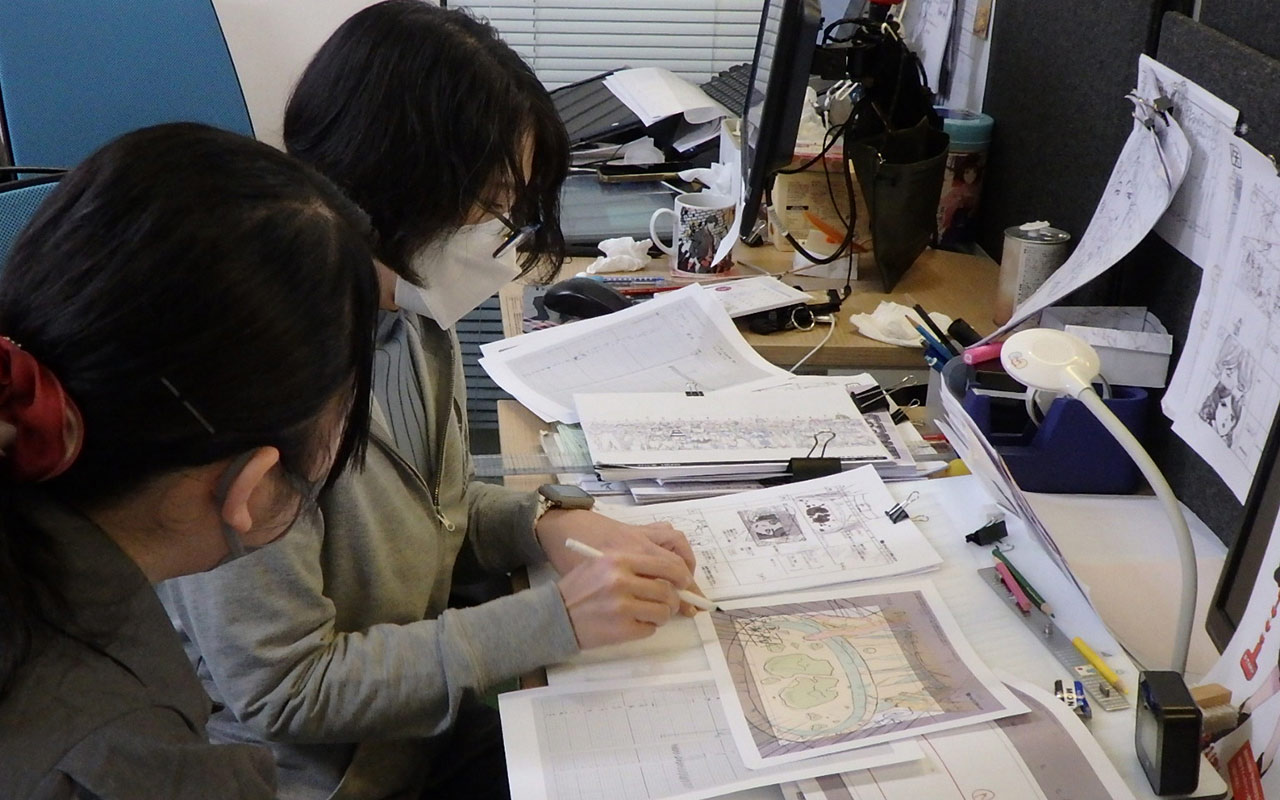
Interview with Instructor M: The Changing Industry and Fostering Animators
・Based on the changes in the anime industry (worldwide growth, increased demand for Japanese anime and so on) in what way is the educational content of the Academy evolving?
The shortage of animators is becoming increasingly serious, and fostering young ones is a matter of urgency. The evolution of CG technology has made the degree of difficulty of hand-drawn work even higher, and the amount of time and effort required to foster new animators is increasing. However, even though the production environment is changing, the basics that we teach in the workplace remain unchanged from the advent of animation to the present day.
By equipping a sound grounding of the basics, the students become armed with the ability to respond to the changing environment, and I believe that this eventually leads to their “evolution.”
・As an instructor, how do you teach a balance of technological evolution and hand drawing skills?
Three-dimensional CG technology is increasingly used to relieve the burden of drawing, but hand-drawn pictures are the basics of anime production. Highly skilled animators can draw anything at or above a certain level. The Academy aims to foster these kinds of “animators with high technical skills.” It is because animators who have an ability to create with their own hands and are equipped with an aesthetic sense cultivated through discipline, are able to appropriately revise machine-calculated data. If they can equip with the ability to accurately express the images from your brain to exactly where they are aiming for, then I think that they can adapt to any field in the future.
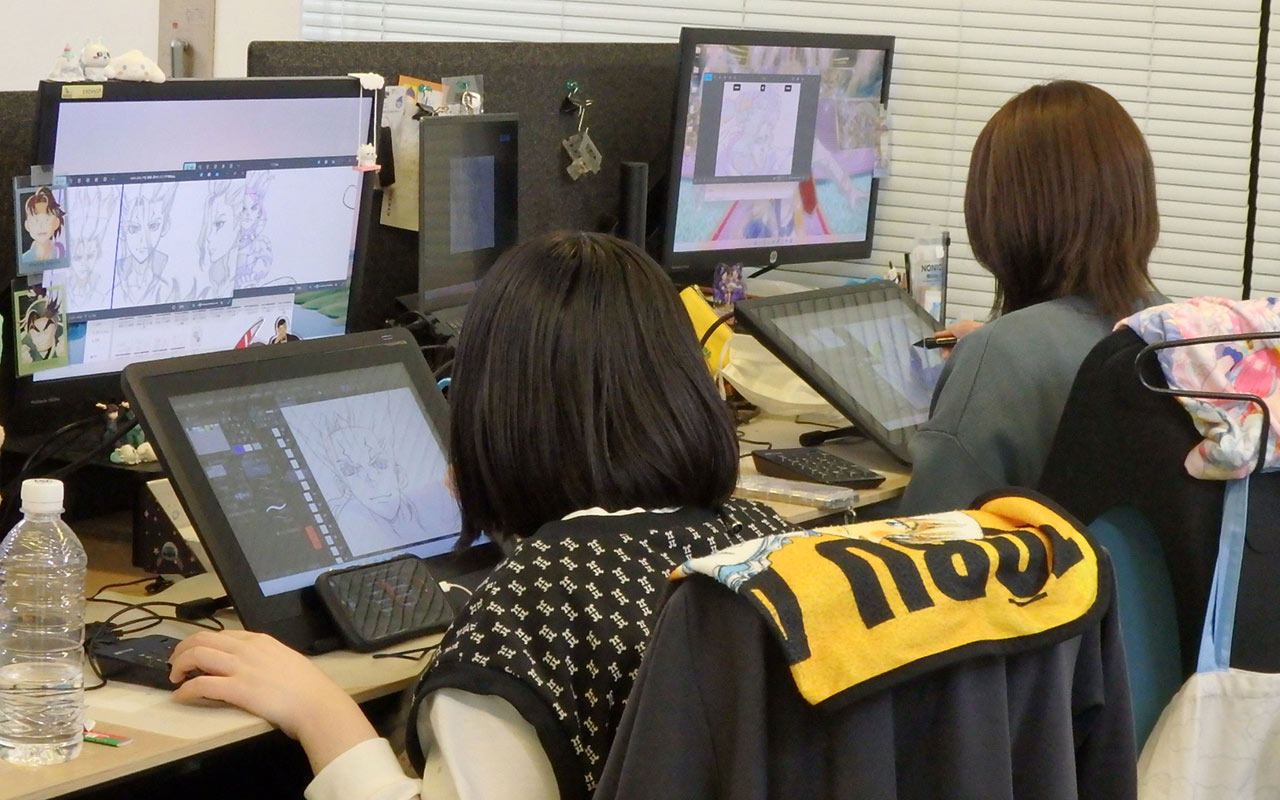
Interview with Academy graduate T: The Experience of Learning
・Making the most of what you learned at the Academy, what sort of skills do you want to polish in the future?
I believe that having been able to thoroughly learn the basics of animation is an enormous asset to me. I face new issues every day, but I think it is because of these basics that I am able to grow. There is not one and only correct answer in drawing and acting, just an infinite number of options. While continuing to cherish the basics and consider all sorts of elements such as my own style, the characteristics of the title, and the individuality of the characters, I would like to polish my own skills by drawing continuously and copiously.
・Do you have any goals or dreams you wish to realize as an animator in the future?
My goal is to deepen my awareness of being a professional animator and become an irreplaceable member of the production workplace. One of my dreams had come true by becoming involved with the production of anime at TMS, and my next dream is to earn enough trust to be designated as “this cut should be done by you.” My dream is to become an essential presence to the company and works, and to continue to contribute to the production of animations that are beloved by viewers. I’m going to carry on honing my skills and creativity and work hard towards these goals.
Through such initiatives TMS achieves both the fostering and securing of outstanding human resources.
5. The New Markets TMS Targets
Growth of TMS Titles in the Chinese Market
While the Japanese anime market matures, in recent years interest in Japanese anime is growing enormously in the rest of Asia, and there are prospects for the further expansion of business.
Among Asian nations, the Detective Conan franchise is steadily earning popularity especially in China. Detective Conan: The Million-dollar Pentagram that was released in mainland China in 2024, recording a box-office revenue of 286 million yuan (approx. 5.8 billion yen), making it the biggest ever hit in the franchise even within China. TMS will continue to strengthen promotion and other initiatives aimed at local audiences, aiming for even more growth.
Strategic Entrance to the Indian Market
Elsewhere around the world, TMS is focusing on Southern Asia, centering on India as the market with potential of growth. In particular, the population of India has already exceeded that of China, and it is expected that the Indian anime market will expand in tandem with its economic growth. In the past, license agreements were only concluded for some old titles, but in recent years TMS has been able to license the TV series of Detective Conan to an Indian broadcaster, achieve simultaneous broadcasting* of new titles such as Honey Lemon Soda, and is steadily developing business in the region.
*Broadcasting shows overseas, simultaneously with or at similar times to the Japanese broadcasts.
6. Prospects for TMS, Continuing to Create Captivating Experiences
In order to respond to these dynamic changes in the anime industry, TMS has continued to evolve through initiatives to change profit structure and solving the issues faced by the whole industry, strategizing for challenges in new markets based on its own ability of anime production developed over the course 60 years of its history.
Going forward, as part of the SEGA SAMMY Group, TMS will aim to improve its corporate value by providing captivating experiences to people across the world through animation production. At the same time, continuously contributing to the development of a sustainability in the anime industry moving forward.
We hope that everybody will look forward to the further growth of TMS.

